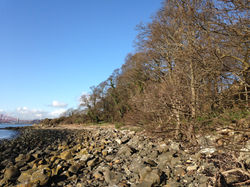Dalgety Bay Community Woodlands Group

 |  |  |  |  |  |  |
|---|---|---|---|---|---|---|
 |  |
Nettle Clearing with Donibristle P7 pupils
in
Bathing House Wood
When we first surveyed Bathing House Wood before it was taken over by the Community Council, one of the most striking characteristics was the abundance of nettles, both alongside the paths and in among the trees. In some parts these overshadowed any other woodland flowers that might have developed and also made life uncomfortable for walkers who sometimes had to brave avenues of stinging leaves. The superabundance of nettles is a consequence of nutrient enrichment; this wood is often the first green space seen by dogs on their morning or evening walk. Before the advent of bins, enabling responsible owners to collect and dispose of their dog’s excrement, the path-sides used to receive a liberal deposit.
In our preparation for the tree planting work in February and March of 2015 some of the nettles were dug out of the areas where the trees were to be planted in commemoration of the fallen of WW1. This was done in order to reduce the competition for water and light when the trees started to grow. Later in the year it was noticed that seed of a wide variety of other woodland plants that had lain dormant in the soil, probably for many years, began to germinate and develop.
The prospect was thus presented that in the following years the drab green of nettle beds in these areas would be replaced by the rosy hues of Red Campion, along with the purple of Hedge Woundwort and other wild woodland flowers. Apart from making these areas more colourful and interesting, having a wider range of plant species would also help to diversify the insect species that make use of them. Not that nettles are not also important for wildlife, there are a range of insects that feed on their leaves, including a couple of our more colourful butterfly species, Red Admiral and Small Tortoiseshell, as well as some moths; but there would be plenty of nettles remaining in other parts of the woods to satisfy their needs.
Out of this then came the suggestion that more nettle clearing could be done, especially along the paths that lead into Bathing House Wood from Swallow Craig and Moray Way South. So it was that in a week near the end of November 2015, pupils from three P7 classes came to Bathing House Wood on three separate mornings to embark on the clearing process in selected areas.
Some were able to bring appropriate tools, but more were supplied by DBCWG volunteers, and Dobbies Garden Centre also contributed some hand forks and trowels. Nettles have shallow spreading roots so it was relatively easy for the children to get the tines of their forks at a shallow angle under the roots and lift out quite large clumps. By this time of the year, the nettles had largely died back so the risk of getting stung was minimised. The nettle roots were added to the existing habitat piles where they would help to increase humidity within the piles of brushwood.
All of this work will help pupils working with the school towards John Muir Trust Awards, one aspect of which is the control of invasive species. Although nettles are not “invasive species” in the league of Rhododendron ponticum or Japanese Knotweed, where they reach high dominance over a wide area, reducing their spread and restoring greater diversity to the woodland flora is a very worthwhile objective.
When they had finished, the cleared areas were very obvious.
For more pictures from the nettle clearing in 2015 see the gallery below
 |  |
|---|---|
 |  |
 |  |
 |  |
 |  |
 |  |
 |  |
 |  |
 |  |
 |  |
 |  |
 |  |
 |






A few nettles sprouted from roots that had been missed, but some clearing of ones closest to the path was then done the following spring.


By and large the cleared areas alongside the paths soon began to develop a wide range of “non-stinging” woodland flowers which was the outcome that had been hoped for.

On the strength of this, a similar nettle clearing group from Donibristle descended on Bathing House Wood in February 2017 to clear more of the path-side nettles.

For more on the February 2017 nettle clearing see the gallery below
 |  |
|---|---|
 |  |
 |  |
 |  |
 |  |
 |  |
 |
As seen above, the most obvious plant to benefit from the clearing along the paths was Cow Parsley, but another area had an extensive growth of a related, but daintier, plant, Rough Chervil. These are both members of the Carrot family as you can tell by their feathery leaves and heads of small white flowers. At a lower level both Hedge Woundwort and White Dead-nettle were able to expand their coverage, and the clearing work also uncovered clumps of Snowdrops that had become hidden beneath the dead stems of the nettles; so these now brighten a late winter walk. Altogether a great reward for the efforts of the Donibristle P7 children.
For pictures of some of the flowers that benefited from the work, see the gallery below.
 |  |
|---|---|
 |  |
 |
The nettles will return of course, but a bit of effort each winter should stop them gaining the upper hand again.